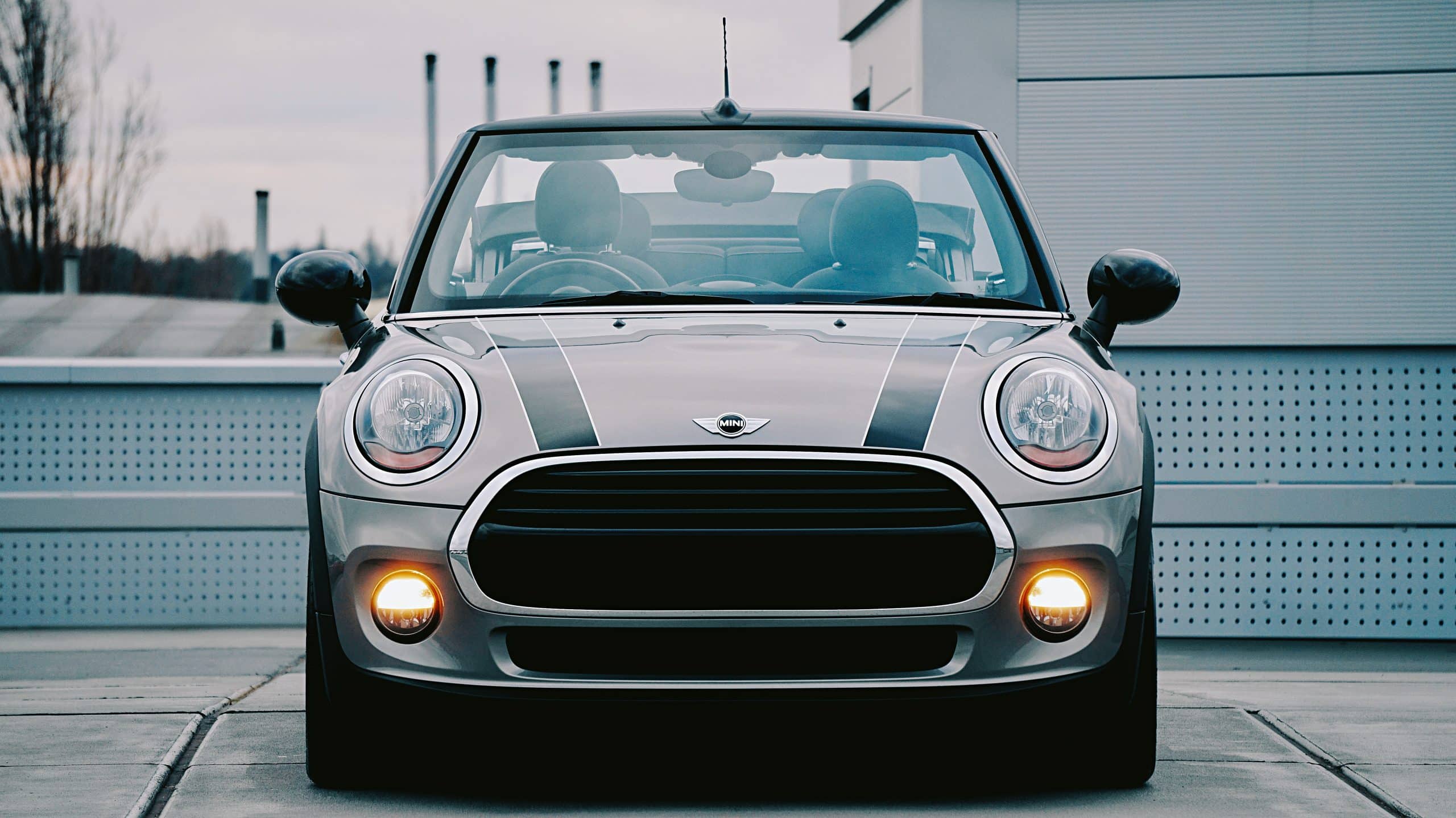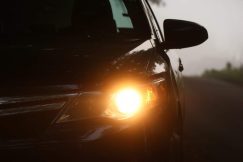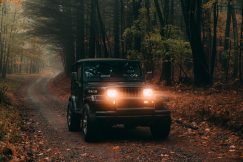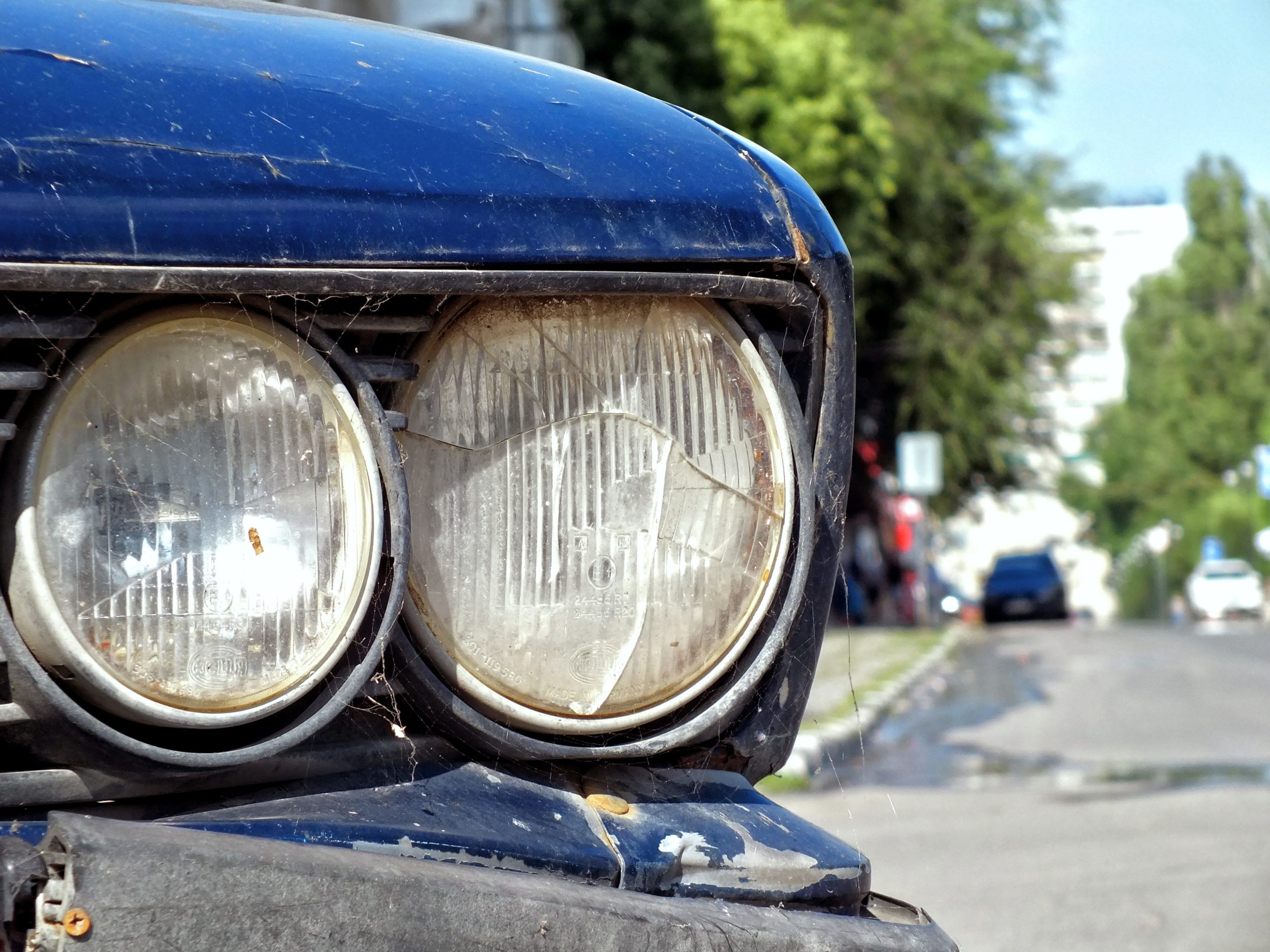Yellow fog lights provide superior visibility in poor weather conditions. The yellow light helps to cut through the fog, snow, and rain more effectively than white or blue light. This allows drivers to see better when driving in low visibility situations, making it safer for them and other drivers on the road. We’ve complied a list of the best yellow fog lights available on the market today.
The XenonPro Single Beam LED Yellow 45W is this year’s winner.
We came to this conclusion by gathering all of the top offerings and comparing the specs side by side.
These LED bulbs from XenonPro rose to the top. The two main factors that lead to this decision are:
- Highest light output available: 9,000 Lumens
- Best warranty offered: lifetime warranty, free replacements
Four bulb types were included in this comparison:
- Halogen
- LED
- HID
- Full fog light housing replacement
Although we found the XenonPro LEDs to be the overall winner for most situations, there are certain circumstances that a bulb type other than LED would be more appropriate. We’ll explore those circumstances and products here.
Best Yellow Fog Light Bulbs:
- XenonPro Single Beam LED Yellow 45W – Best Overall & Best LED
- Hella Xtreme Yellow – Best Halogen
- Innovited HID Golden Yellow – Best HID
- Diode Dynamics Stage Series 3 Max LED Fog Light Yellow – Best Housing Replacement
Why Yellow Fog Lights?
Fog lights are yellow because yellow light is easier for the human eye to see during rain, fog, and snow. This is accomplished by removing short, blue to violet wavelengths. Blue to violet wavelengths can be perceived as glare during low-visibility weather conditions. The technical term for this yellow light is selective yellow.
Yellow lenses, filters, or films are often used by bulb manufacturers to achieve this yellow light output. This can result in a light output reduction of up to 15%. However, the loss in light output is made up by the increase in visibility offered by the yellow light. In addition to improved visibility, the yellow light is also more comfortable for the human than light that is white or blue.
In summary, yellow light, during foggy, rainy, or snowy conditions not only brings less eye discomfort, it also provides better visibility when compared to light on other parts of the spectrum, namely blue to violet.
Color Temperature Fundamentals
As you consider your fog light options, you’ll see manufacturers describe the color of the light their bulbs emit using color temperature. Here is the basic color temperature scale:

The color temperature scale runs from the color of a match flame on the low end, daylight in the middle, and the blue of the sky at other end. The light is measured in Kelvin or K. For example, yellow fog lights have a color temperature of 2,500 K – 3,500 K.
Under normal conditions, the human eye sees best with color from 5,000 K – 6,500 K. These happen to be the color of the sun during daylight hours. However, during weather conditions like fog, snow, and rain, light in that range of the spectrum becomes glare and difficult to look at.
Yellow light is ideal during low visibility circumstances.
How Yellow Light Is Made
Yellow light is made in two main ways:
- Filter, lense, or film
- Metal halide (HID)
Using filters, lenses, or films is the most common way most bulb manufacturers create yellow light. The downside to this is that is can result in up to 15% light output loss. This is not bad, especially if the light source is plenty bright.
Specialized metal halide mixtures found in HID headlight bulbs are capable to producing colors from 3,000 K to over 20,000 K. This is done without the use of filters, so light output is not decreased.
The downside to metal halide headlight bulbs (HID) is that they take time to warm up. This type of bulb is not capable or producing maximum light output immediately. The color and the output require specific pressure and temperature to reach optimal levels.
Yellow Fog Light Bulb Types
There are 4 yellow fog light types, which are:
Halogen fog light bulbs are a traditional incandescent bulb. They use a tungsten filament sealed in a glass bulb that is filled with inert gas and a small amount of iodine or bromine. Most vehicles are equipped from the factory with halogen bulbs. They are inexpensive to make and produce a decent amount of light. The downsides are that they don’t usually last very long, and they require a lot of power to operate, compared to more modern LEDs.
LED fog lights use a light emitting diode (LED) as it’s light source. A LED is a semiconductor that produces light when electricity flows through it. LEDs produce much more light per unit of electricity than halogen bulbs and have a lifespan that is significantly longer. LEDs are currently the leading technology when it comes to automotive lighting, including fog lights.
HID fog lights use a metal halide mixture, combined with an electrical current as its light source. Light is produced as the electricity arcs between two tungsten electrodes inside of a gas chamber. HID light begins as a very bright light source, but can deteriorate by up to 70% over the span of only 10,000 hours.
We’re including a fourth type of yellow fog light here realizing it’s not technically a bulb type. However, it’s a very competitive option when considering new yellow fog light bulbs. This option replaces the entire fog light housing with a new one. The highest performing usually use LEDs as their light source.
Side-by-Side Comparison
| XenonPro | Hella | Innovited | Diode Dynamics Max | |
| Light Source | LED | Halogen | HID | LED (housing replacement) |
| Color | 3,000 K | 2,900 K | 3,000 K | 3,000 K |
| Brightness (pair) | 9,000 LM | 2,690 LM | 3,300 LM | 15,840 LM |
| Watts | 45W | 55W | 35W | 38.5 W |
| Cooling Type | Micro-fan | none | none | Aluminum heat sink |
| Lifespan | 45,000 hrs | 1,000 hrs | 5,500 hrs | not specified |
| Warranty | Lifetime | none | 2 yrs | 8 yrs |
| Country of Origin | USA | Korea | not specified | USA |
| Waterproof | Yes | NA | Yes | not specified |
| Street Legal | Yes | Yes | Yes | Yes |
#1 – XenonPro Single Beam LED Yellow 45W
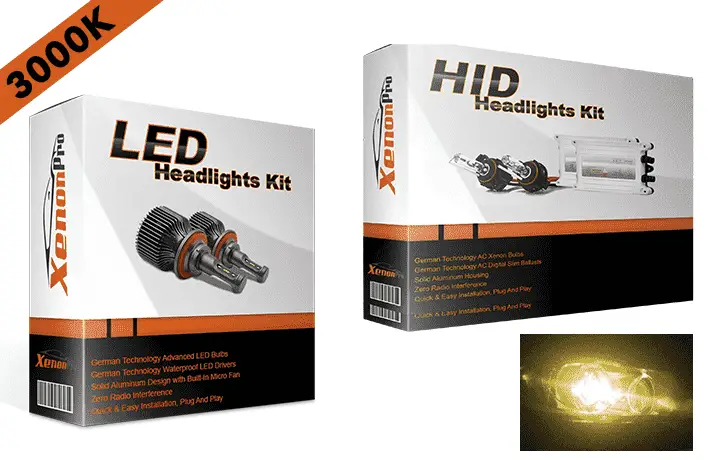
- Yellow Color Option: 3000k
- Warranty: Lifetime
- Installation: “Plug & Play”
- Technical Support Available from Manufacturer: Yes
- Available Technology: HID and LED
XenonPro offers yellow fog light bulbs (3000K color temperature) in both HID and LED technology. The LED options will be brighter, last longer, and be easier to install but slightly more expensive.
Regardless of the technology, each kit comes with a pair of super-bright performance bulbs available in all sizes, a premium-quality build, and a lifetime warranty, taking the number one spot for the best yellow fog lights.
Both the HID and LED options will be significantly brighter than stock halogens and will last a lot longer. XenonPro boasts superior lighting technology and energy efficiency for each of their product with a proven track record, providing better visibility among other best yellow fog light bulbs.
Pros:
- Available in both LED and HID technology
- Premium quality build, scored 4.7 stars on over 25,000 reviews
- 7 color options (pure yellow, whiteish-yellow, white, ice blue, blue, dark blue, purple)
- 40 bulb sizes including H11, 9005, 9006, D1S, D2S, D2R, and more
- Energy-efficient and long-lasting
- Really fast and free shipping
- Lifetime warranty
Cons:
- It cannot be used for cars with stock HID fog lights
- It cannot be used for cars with stock LED fog lights
- HID kit may require help for installation (wiring and plugs are simple but strapping ballast may require some experience and finesse)
HID vs. Halogen Fog Lights
Halogen Fog Lights
Halogen fog lights can be compared to your old school incandescent light bulbs found at home. Appearing first on the scene of automotive, almost every vehicle on the market has halogen headlamps as standard equipment.
It is popular as it cuts low on the cost of production, making it easy to manufacture with a lifetime of 1000 hours, depending on its exposed conditions. It looks yellowish, making it unable to produce much visibility compared to HID bulbs. It begins to glow brightly when the thin wire filament housed inside a chamber of halogen gas is heated up, giving off light and wasting energy in the process.
Another downside of halogen bulbs is that the filament is quite fragile and runs the risk of shattering if you are driving your vehicle over very rough and bumpy tracks, requiring extra handling care. It was mainly for headlight purposes but will also look fantastic as fog lights as it gives an elegant feel to your car.
In addition, Halogen light bulbs finally took a step up! You can now find a white and blue variation depending on the factory it comes from.
High-Intensity Discharge (HID) Fog Light Bulbs
HID Bulbs are also known as Xenon Bulbs. For it to work, the bulbs create light by striking an ultra-bright arc between two electrodes that are housed inside a chamber of xenon gas and evaporated metal salts. The HID lighting is conducted when electricity is applied to metal vapor. For a better picture, it produces light in the same manner as fluorescent lights. HIDs have a long lifespan, estimated at around 2,000 hours.
You will need the ballast for your HID lights for continuous operation, supplying the bulbs with a continuous amount of power so that the electric arc will not flicker.
Since no fragile filaments are used, the HID bulb is much more durable, unlike the Halogen bulb. It also produces a bright white light that allows more visibility. While it can totally outperform the halogen bulb with its better technology, it has some key flaws: it’s costly, drains your battery fast but has a longer lifespan than the Halogen light bulb, and may also cause glare issues and lag time for full brightness.
It is hard to describe HID colors accurately since many variables such as voltage, type of ballast, and the environment can affect color output. Also, color perception is subjective.
HID bulbs may sometimes contain harmful substances that may be hazardous to our health, so they must be handled and disposed of with utmost care.
Today, HID bulbs are popular as cosmetic add-ons for automotive vehicles rather than for basic use.
The Benefit of Yellow Light While Driving In Fog
Fog lights are just one kind of auxiliary light. Of course, there are others — like driving lights and mid beams for passing, including spotlights. Fog lights are not necessarily yellow. Personally, I am more inclined to turn on my best yellow fog light bulbs as they do not blind me, especially during long drives at night. Rocky roads can be quite dangerous as well if you use too much light, omitting the potential hollows you might drive upon.
But is yellow light really beneficial? Does it penetrate the fog better, as the infamous myth says? Does it really reflect less of the dust particles? Or is it just a tradition that France started?
There have been countless arguments as to why “Selective Yellow Light” is the most beneficial, especially during nighttime driving. To answer those: No, none of those are correct, but the latter one has greatly affected the utilization of these “Selective Yellow Lights,” even though the reasons were unclear why France started and held on to that law for more than 60 years before allowing white headlights for the first time in 1937.
“Selective yellow light” may help improve a driver’s ability to navigate in snow or fog or rain, but not because it reflects droplets or dustless or penetrates fog better. In fact, it is due to the way our eyes process different colors of light. Blue, indigo, and violet are the shortest visible wavelengths. They tend to focus in front of our retina rather than upon it. That is why it is difficult for the human eye to process correctly, creating a glare that can blind us temporarily.
Studies have shown that blue headlamps stimulate the reaction we call glare to almost 46% as compared to the yellower ones for the same intensity, but it is not the basis for determining how good your lights are. The best yellow fog light bulbs are chosen by the beam pattern they deliver, which is most present in tungsten-halogen bulbs.
What to Look for When Shopping for Yellow Fog Light Bulbs
Having these cute little flashers on your baby would totally make you rock, but it does not give the assurance of getting the most function out of it.
I hope that the pros and cons that I have listed will guide you in choosing the best yellow fog light bulbs you longed for.
- Price. Some bulbs may be highly-priced but are near as trash as the cheapest ones. Look for something that looks reasonable for that set price.
- Quality. It is widely known that all brands want to call their item the best quality. Some may look classy but do not even last a week. Some may look shabby but still work well for years.
- Performance. Points for this category lie basically in our personal tastes. Some may want it elegant and classic; some may want it bright and new.
Please, also take into consideration your topographic location. The key point is: that fog lamps are meant to be used in snow, rain, or heavy fog to help drivers safely advance their way with ample allowance to see the sides of the road.
Conclusion
Fog lights, especially HID and LED, are quickly climbing up and setting new trends, selling like fresh the oven pizzas, especially for car customization enthusiasts. New technology means a new generation of lighting. Although some mistakenly believe that they can see better with them, fog lights should be turned off most of the time unless extremely needed.
If you’re looking for performance, go HID. If you’re looking for the optimum lighting purpose, go for halogen bulbs. I cannot recommend a specific one as both types of these best yellow fog light bulbs do relatively well for certain purposes, even with their pros and cons.
It’s purely up to you if you want to join the bandwagon of cool kids from the block or you just want to keep them for emergency purposes. My most important advice is to keep those lights low-key, or you will be singing “Baby come back” behind cold bars.

